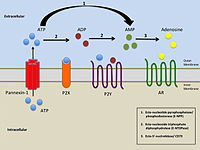
Cotransporters are a subcategory of membrane transport proteins (transporters) that couple the favorable movement of one molecule with its concentration gradient and unfavorable movement of another molecule against its concentration gradient. They enable coupled or cotransport and include antiporters and symporters. In general, cotransporters consist of two out of the three classes of integral membrane proteins known as transporters that move molecules and ions across biomembranes. Uniporters are also transporters but move only one type of molecule down its concentration gradient and are not classified as cotransporters.

Glucose transporters are a wide group of membrane proteins that facilitate the transport of glucose across the plasma membrane, a process known as facilitated diffusion. Because glucose is a vital source of energy for all life, these transporters are present in all phyla. The GLUT or SLC2A family are a protein family that is found in most mammalian cells. 14 GLUTS are encoded by human genome. GLUT is a type of uniporter transporter protein.
The solute carrier (SLC) group of membrane transport proteins include over 400 members organized into 66 families. Most members of the SLC group are located in the cell membrane. The SLC gene nomenclature system was originally proposed by the HUGO Gene Nomenclature Committee (HGNC) and is the basis for the official HGNC names of the genes that encode these transporters. A more general transmembrane transporter classification can be found in TCDB database.
CD98 is a glycoprotein that is a heterodimer composed of SLC3A2 and SLC7A5 that forms the large neutral amino acid transporter (LAT1). LAT1 is a heterodimeric membrane transport protein that preferentially transports branched-chain and aromatic amino acids. LAT is highly expressed in brain capillaries relative to other tissues.
Sodium-dependent glucose cotransporters are a family of glucose transporter found in the intestinal mucosa (enterocytes) of the small intestine (SGLT1) and the proximal tubule of the nephron. They contribute to renal glucose reabsorption. In the kidneys, 100% of the filtered glucose in the glomerulus has to be reabsorbed along the nephron. If the plasma glucose concentration is too high (hyperglycemia), glucose passes into the urine (glucosuria) because SGLT are saturated with the filtered glucose.
The Na-K-Cl cotransporter (NKCC) is a transport protein that aids in the secondary active transport of sodium, potassium, and chloride into cells. In humans there are two isoforms of this membrane transport protein, NKCC1 and NKCC2, encoded by two different genes. Two isoforms of the NKCC1/Slc12a2 gene result from keeping or skipping exon 21 in the final gene product.

GLUT5 is a fructose transporter expressed on the apical border of enterocytes in the small intestine. GLUT5 allows for fructose to be transported from the intestinal lumen into the enterocyte by facilitated diffusion due to fructose's high concentration in the intestinal lumen. GLUT5 is also expressed in skeletal muscle, testis, kidney, fat tissue (adipocytes), and brain.

Equilibrative nucleoside transporter 2 (ENT2) is a protein that in humans is encoded by the SLC29A2 gene.

Concentrative nucleoside transporter 2 (CNT2) is a protein that in humans is encoded by the SLC28A2 gene.

Monocarboxylate transporter 5 is a protein that in humans is encoded by the SLC16A4 gene.

Concentrative nucleoside transporter 1 (CNT1) is a protein that in humans is encoded by the SLC28A1 gene.
An amino acid transporter is a membrane transport protein that transports amino acids. They are mainly of the solute carrier family.

Monocarboxylate transporter 4 (MCT4) also known as solute carrier family 16 member 3 is a protein that in humans is encoded by the SLC16A3 gene.

The plasma membrane monoamine transporter (PMAT) is a low-affinity monoamine transporter protein which in humans is encoded by the SLC29A4 gene. It is known alternatively as the human equilibrative nucleoside transporter-4 (hENT4). Unlike other members of the ENT family, it is impermeable to most nucleosides, with the exception of the inhibitory neurotransmitter and ribonucleoside adenosine, which it is permeable to in a highly pH-dependent manner.

Solute carrier organic anion transporter family member 2A1, also known as the prostaglandin transporter (PGT), is a protein that in humans is encoded by the SLCO2A1 gene.

Acetyl-coenzyme A transporter 1 also known as solute carrier family 33 member 1 (SLC33A1) is a protein that in humans is encoded by the SLC33A1 gene.

Glucose-6-phosphate exchanger SLC37A2 is a protein that in humans is encoded by the SLC37A2 gene.
Members of the Equilibrative Nucleoside Transporter (ENT) Family are transport proteins that are specific to nucleosides and nucleobases, and are part of the major facilitator superfamily. They generally possess at least 6, typically 10, transmembrane segments (TMSs) and are 300-600 amino acyl residues in length.

Glucose-6-phosphate exchanger SLC37A1 is a protein that in humans is encoded by the SLC37A1 gene. SLC37A1 locates to the membrane of the endoplasmic reticulum (ER), and is a glucose 6-phosphate:inorganic phosphate antiporter, transporting glucose 6-phosphate from the cytoplasm into the lumen of the ER, while transporting phosphate in the opposite direction.
Proton-coupled amino acid transporters belong to the SLC26A5 family; they are protein receptors whose main function is the transmembrane movement of amino acids and their derivatives. This family of receptors is most commonly found within the luminal surface of the small intestine as well as in some lysosomes. The solute carrier family (SLC) of genes includes roughly 400 membrane proteins that are characterized by 66 families in total. The SLC36 family of genes maps to chromosome 11. The diversity of these receptors is vast, with the ability to transport both charged and uncharged amino acids along with their derivatives. In research and practice, SLC36A1/2 are both targets for drug-based delivery systems for a wide range of disorders.









